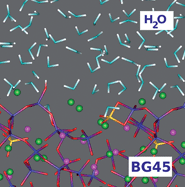Models of structure, dynamics and reactivity of bioglasses: a review
Abstract
Due to their high biocompatibility and osteoconductivity, bioactive silicate glasses are the core components of biomaterials used to repair, restore and regenerate bone and tissues in the human body. One of the key features, which control their bioactivity, is the fast surface dissolution in a biological medium, with the release of critical amounts of ions in the surrounding environment. Being able to understand these inorganic processes at the atomistic level is essential if a more rational approach to the use of these materials is sought. Over the past five years, atomistic simulations of bioglasses have revealed details of bulk structural features which affect the glass dissolution and thus its bioactivity, such as the connectivity of the silicate network and the tendency to form chains, rings and


 Please wait while we load your content...
Please wait while we load your content...